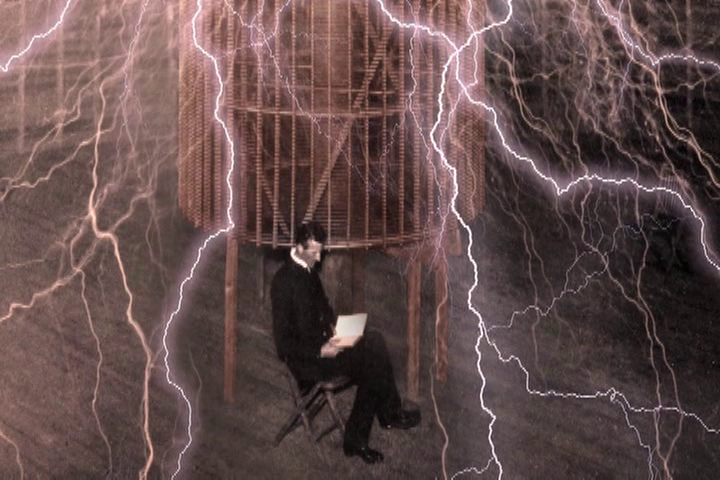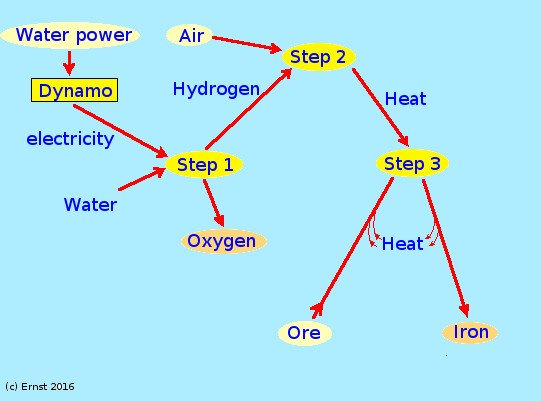Here we are in 2018, over a hundred years later speculating about what could have been Nikola Tesla’s secret. I then think to myself: if only I could show you what I read, you would understand that there is no secret. When I read his articles and patents from 1900 onward, what I see is a man desperately trying to get his views across. He tries again and again in many different ways, but no-one seems to see what I see.

It is my sincere wish that one day people will read Tesla’s articles and really understand what he is saying.
So… Let me take you by the hand an walk you through his most famous article: “The Problem of Increasing Human Energy”, published in Century Illustrated Magazine of June 1900.
In this seventh part we look at the production of iron… or… do we?
You’re going to love this one.
Previous parts can be found here:
Part 1: Laying a foundation
Part 2: What is electricity?
Part 3: Burning Nitrogen...
Part 4: How to overcome natural resistance
Part 5: Telautomatics
Part 6: Introduction to Harnessing the Sun’s Energy
We continue in the main article where we’d left off.
GREAT POSSIBILITIES OFFERED BY IRON FOR INCREASING HUMAN PERFORMANCE
—ENORMOUS WASTE IN IRON MANUFACTURE.
Iron is by far the most important factor in modern progress. It contributes more than any other industrial product to the force accelerating human movement. So general is the use of this metal, and so intimately is it connected with all that concerns our life, that it has become as indispensable to us as the very air we breathe. Its name is synonymous with usefulness. But, however great the influence of iron may be on the present human development, it does not add to the force urging man onward nearly as much as it might. First of all, its manufacture as now carried on is connected with an appalling waste of fuel—that is, waste of energy. Then, again, only a part of all the iron produced is applied for useful purposes. A good part of it goes to create frictional resistances, while still another large part is the means of developing negative forces greatly retarding human movement. Thus the negative force of war is almost wholly represented in iron. It is impossible to estimate with any degree of accuracy the magnitude of this greatest of all retarding forces, but it is certainly very considerable. If the present positive impelling force due to all useful applications of iron be represented by ten, for instance, I should not think it exaggeration to estimate the negative force of war, with due consideration of all its retarding influences and results, at, say, six. On the basis of this estimate the effective impelling force of iron in the positive direction would be measured by the difference of these two numbers, which is four. But if, through the establishment of universal peace, the manufacture of war machinery should cease, and all struggle for supremacy between nations should be turned into healthful, ever active and productive commercial competition, then the positive impelling force due to iron would be measured by the sum of those two, numbers, which is sixteen—that is, this force would have four times its present value. This example is, of course, merely intended to give an idea of the immense increase in the useful performance of mankind which would result from a radical reform of the iron industries supplying the implements of warfare.
Iron now stands for electricity or electrical energy and this chapter is particularly interesting because Tesla gives us the general overview of his system. But first he mentions that we are wasting most of the energy that we have at our disposal. We should create the desired effects in a much more efficient way.
A similar inestimable advantage in the saving of energy available to man would be secured by obviating the great waste of coal which is inseparably connected with the present methods of manufacturing iron. In some countries, such as Great Britain, the hurtful effects of this squandering of fuel are beginning to be felt. The price of coal is constantly rising, and the poor are made to suffer more and more. Though we are still far from the dreaded "exhaustion of the coal-fields," philanthropy commands us to invent novel methods of manufacturing iron, which will not involve such barbarous waste of this valuable material from which we derive at present most of our energy. It is our duty to coming generations to leave this store of energy intact for them, or at least not to touch it until we shall have perfected processes for burning coal more efficiently. Those who are coming after us will need fuel more than we do. We should be able to manufacture the iron we require by using the sun's energy, without wasting any coal at all. As an effort to this end the idea of smelting iron ores by electric currents obtained from the energy of falling water has naturally suggested itself to many. I have myself spent much time in endeavouring to evolve such a practical process, which would enable iron to be manufactured at small cost. After a prolonged investigation of the subject, finding that it was unprofitable to use the currents generated directly for smelting the ore, I devised a method which is far more economical.
Note the phrase “barbarous waste of this valuable material from which we derive at present most of our energy.” We derive most of our energy from…. what ...
Also “We should be able to manufacture the iron we require by using the sun's energy, without wasting any coal at all.” That is what this article is all about; we should derive our electricity from the medium without burning fuel.
ECONOMICAL PRODUCTION OF IRON BY A NEW PROCESS.
The industrial project, as I worked it out six years ago, contemplated the employment of the electric currents derived from the energy of a waterfall, not directly for smelting the ore, but for decomposing water for a preliminary step. To lessen the cost of the plant, I proposed to generate the currents in exceptionally cheap and simple dynamos, which I designed for this sole purpose. The hydrogen liberated in the electrolytic decomposition was to be burned or recombined with oxygen, not with that from which it was separated, but with that of the atmosphere. Thus very nearly the total electrical energy used up in the decomposition of the water would be recovered in the form of heat resulting from the recombination of the hydrogen. This heat was to be applied to the smelting of ore. The oxygen gained as a by-product of the decomposition of the water I intended to use for certain other industrial purposes, which would probably yield good financial returns, inasmuch as this is the cheapest way of obtaining this gas in large quantities. In any event, it could be employed to burn all kinds of refuse, cheap hydrocarbon, or coal of the most inferior quality which could not be burned in air or be otherwise utilized to advantage, and thus again a considerable amount of heat would be made available for the smelting of the ore. To increase the economy of the process I contemplated, furthermore, using an arrangement such that the hot metal and the products of combustion, coming out of the furnace, would give up their heat upon the cold ore going into the furnace, so that comparatively little of the heat energy would be lost in the smelting. I calculated that probably forty thousand pounds of iron could be produced per horse-power per annum by this method. Liberal allowances were made for those losses which are unavoidable, the above quantity being about half of that theoretically obtainable. Relying on this estimate and on practical data with reference to a certain kind of sand ore existing in abundance in the region of the Great Lakes, including cost of transportation and labour, I found that in some localities iron could be manufactured in this manner cheaper than by any of the adopted methods. This result would be obtained all the more surely if the oxygen obtained from the water, instead of being used for smelting of ore, as assumed, should be more profitably employed. Any new demand for this gas would secure a higher revenue from the plant, thus cheapening the iron. This project was advanced merely in the interest of industry. Some day, I hope, a beautiful industrial butterfly will come out of the dusty and shrivelled chrysalis.
First notice the last sentence. This clearly indicates that Tesla was anticipating that he could not complete this during his days. He worked out the details and passed them on to a future discoverer.
Anyway, here we have the outline of his process
It is interesting to note that in May 1900 Tesla filed a patent application 17,612 for this process. That is 1 month after this article and not 6 years before. Which to me shows that this process is an analogy of another process that he invented earlier, but while describing this analogy he thought this may be a good and workable thing as well.
We already know that iron stands for electricity but the other components are uncertain at this point. It is interesting to note that the self-acting machine seems to use cold instead of heat and in explaining that device Tesla also refers to splitting water into hydrogen and oxygen.
In step 2 we get a component from the air, which we already know: ions produced by cosmic rays. And step 3 is followed by a heat exchange, this too we will recognize when we get to the self-acting engine.
Next Tesla says: “--- a certain kind of sand ore existing in abundance in the region of the Great Lakes ---”. Let me get a (google-)map of that area:

The marker “A” is set at the Niagara Falls where Tesla's design for a hydro electric power plant was implemented. If iron stands for electricity, then iron-ore would be a source of electricity. But the 'sand ore' (water power) is not the 'iron ore' of the diagram. (which is probably why Tesla used a different term) This iron ore is the Earth’s electric charge as will become more apparent later on.
The production of iron from sand ores by a process of magnetic separation is highly commendable in principle, since it involves no waste of coal; but the usefulness of this method is largely reduced by the necessity of melting the iron afterwards. As to the crushing of iron ore, I would consider it rational only if done by water-power, or by energy otherwise obtained without consumption of fuel. An electrolytic cold process, which would make it possible to extract iron cheaply, and also to mould it into the required forms without any fuel consumption, would, in my opinion, be a very great advance in iron manufacture. In common with some other metals, iron has so far resisted electrolytic treatment, but there can be no doubt that such a cold process will ultimately replace in metallurgy the present crude method of casting, and thus obviating the enormous waste of fuel necessitated by the repeated heating of metal in the foundries.
“The production of iron from sand ores by a process of magnetic separation”, translates to “the production of electricity from water power by (magnetic) generators”. After being generated it has to be transformed up for distribution and down to the required voltage for usage (hence repeated melting). Notice how Tesla mentions time and time again that energy must be obtained without burning of fuels, and also how he often describes waste as 'barbarous'. (BTW., a 'radical departure' is also a common phrase)
Up to a few decades ago the usefulness of iron was based almost wholly on its remarkable mechanical properties, but since the advent of the commercial dynamo and electric motor its value to mankind has been greatly increased by its unique magnetic qualities. As regards the latter, iron has been greatly improved of late. The signal progress began about thirteen years ago, when I discovered that in using soft Bessemer steel instead of wrought iron, as then customary, in an alternating motor, the performance of the machine was doubled. I brought this fact to the attention of Mr. Albert Schmid, to whose untiring efforts and ability is largely due the supremacy of American electrical machinery, and who was then superintendent of an industrial corporation engaged in this field. Following my suggestion, he constructed transformers of steel, and they showed the same marked improvement. The investigation was then systematically continued under Mr. Schmid's guidance, the impurities being gradually eliminated from the "steel" (which was only such in name, for in reality it was pure soft iron), and soon a product resulted which admitted of little further improvement.
Stay tuned, much more to come.

I remain tuned in... Thank you for this great series! :D
😄😇😄

Thank you for your interest and continued support!